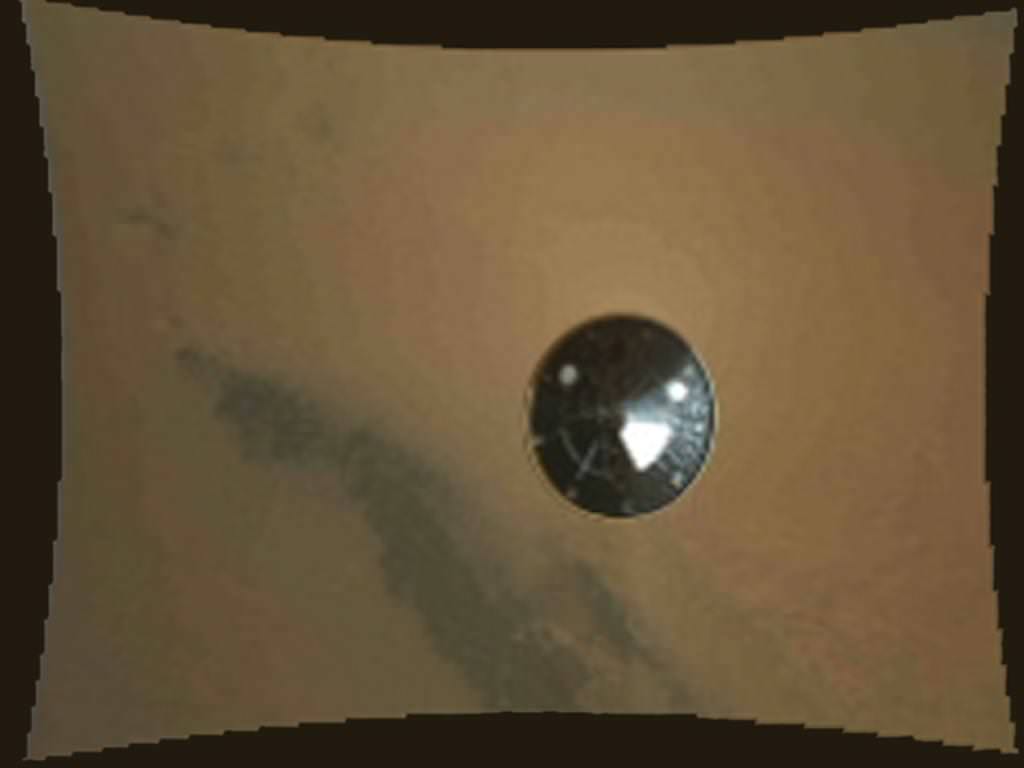Image Caption: Curiosity Heat shield falls away from the bottom of Curiosity and the Sky Crane descent stage in this image from the MARDI camera.
Watch the video below. Credit: NASA/JPL/MSSS
As NASA’s Curiosity Mars Science Lab (MSL) was in the final stages of her flawless but harrowing decent to Gale Crater on Mars overnight (Aug. 5/6) employing the never-before-used rocket powered sky crane descent stage, dramatic movie-like imagery of the plunge was being recorded by MARDI, the Mars Descent Imager camera positioned on the belly of the rover and pointed downwards.
The first low resolution MARDI images and video (above and below) were beamed back to Earth just hours after landing and clearly show the jettisoning of the heat shield moments after it sprung loose to expose Curiosity and MARDI for landing.
“We see the heat shield falling away about 2 minutes and 30 seconds from touchdown,” said Mike Malin, MARDI Principal Investigator from Malin Space Systems at a post-landing news briefing today (Aug. 6). “The heat shield is about 16 meters (50 ft) away in the image and 4.5 m (15 ft) across.”
“I’m very excited to be at Gale Crater”.
“So far we have received about 297 thumbnail images (192 x 144 pixels) so far and created a stop motion video. MADRI was collecting images at 4 frames per second. In the final frames you can see dust being kicked up the rocket engines.”
Curiosity landed at 1:32 on Aug. 6, EDT (11:32 p.m. Aug. 5, PDT), near the foot of a mountain three miles(5 km) tall inside Gale Crater, 96 miles (154 km) in diameter.
Video Caption: The Curiosity Mars Descent Imager (MARDI) captured the rover’s descent to the surface of the Red Planet. The instrument shot 4 fps video from heatshield separation to the ground. Credit: NASA/JPL/MSSS
“The image sequence received so far indicates Curiosity had, as expected, a very exciting ride to the surface,” said Mike Malin, imaging scientist for the Mars Science Lab mission from Malin Space Systems in San Diego. “But as dramatic as they are, there is real other-world importance to obtaining them. These images will help the mission scientists interpret the rover’s surroundings, the rover drivers in planning for future drives across the surface, as well as assist engineers in their design of forthcoming landing systems for Mars or other worlds.”
“A good comparison is to that grainy onboard film from Apollo 11 when they were about to land on the moon,” said Malin.
Over 1500 hundred more low and high resolution MARDI images (1600 x 1200 pixels) will be sent back over the next few weeks to make a full frame animation and will provide the most complete and dramatic imagery of a planetary landing in the history of exploration.
The team has been able to determine Curiosity’s location to “within” about 1 meter says Malin, by matching the MARDI and MRO HiRISE images as well as the Hazcam images.
“So far the rover is healthy and we are ecstatic with its performance,” said Jennifer Trospher, MSL mission manager
The next steps are to deploy the high gain antenna (HGA), raise the mast with the higher resolution cameras and continue to check out the mechanical and electrical systems as well the science instruments as the rover is transitioned to surface operations mode.


We’re talking a “WHA WHOOO!” moment here! Yasssss…..
Hopefully the MSL is given time to drive over to the Sky Crane to show what condition it’s in and get some historic family snapshots. The European Exo-Mars rover has a tough act to follow.
Indeed, although I don’t intend to be disrespectful, Europe appears to have contracted Russia for their Exo-Mars landing system. As we all know, their track record for Mars Exploration is abysmal. Oddly enough, Europe will be building a Martian landing demonstrator, for 2016, just show that their technology works. Why not scale up for the Rover for 2018? Not enough time, $$? Say Russia proves incompetent for their lander design. Will NASA hear desperate banging fists on their front door in a few years from now?
Visiting the cast off materials, the sky crane and the top shield plus parachute, is probably not a high priority. If Curiosity does make some visit it will likely be at a distance, and only if these are near the intended path up this large mountain. Imagine the prospect of the rover getting snagged up in parachute lines, sky crane cables, or getting a wheel jammed up with some piece.
LC
I don’t think they’ll go to the remains of the skycrane. It contains 140 kg of Hydroxyzine, which is very toxic and corrosive to the instruments on board MSL.
Hydrazine maybe ?!
Johan is right… NASA’s decided there’s too much risk…. But the MRO should get some images of the crash site. That in itself should prove insightful. If by off chance the crash landing caused the remaining fuel to explode, and the rover’s path just happens to coincide with the site… then maybe?
I stand in awe. This was a truly great achievement in the true sense of great. Congratulations, USA, from an Aussie. I feel as if I’ve seen history.
This is so cool!
Like the moon, it’s confusing as there is no sense of scale. Can’t wait for the HD images.
Corny perhaps, but its cool to know exactly where you where, and what you where doing when this video was taken by Curiosity.
Remarkable.
Totally awesome. I had to agree, if we could have watched from the surface – say a Pre-set camera, it would be like a Sci-Fi special effects movie … but it was NOT. It was/is the real thing! KUDOS PLUS NASA/JPL … VERY WELL DONE!!